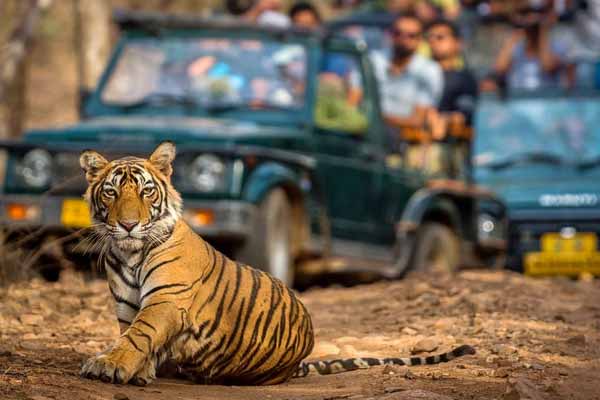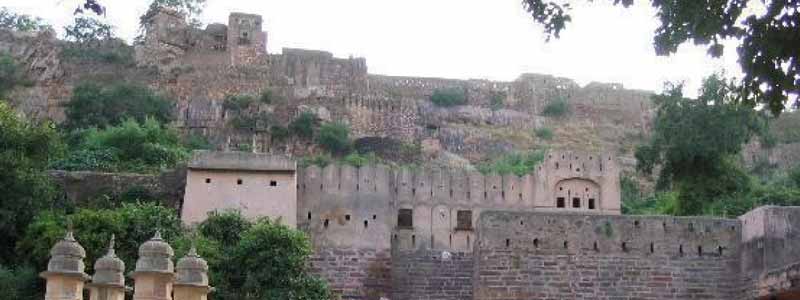8 Major Tourist Attractions Ranthambore, Talking about the places to visit in Ranthambore, some of the most beautiful tourist destinations in the world will be given here. Places such as Ranthambore Fort, renowned for its complex architecture, and the Rajiv Gandhi Regional Museum, known for its ancient antique and craft collections, have drawn tourist flocks. Besides these sites, The tourists have been provided with a much needed natural hidepot away from the monotonous life of the city by some landmarks such as Kachida Valley and Ranthambore National Park.

Various wildlife lovers and nature lovers are attracted to their rich variety of flora and fauna by the tourist places to visit in Ranthambore. By visiting the popular Ranthambore tiger reserve, in their natural habitat, one will be able to see Royal Bengal tigers, wild bears, and boars. One of Ranthambore’s key highlights is its fort, which is home to some of the beautiful royal palaces, former rulers’ ruins, adventure sports, and many other amazing things.
You can also indulge in lots of adventure activities available in these places to visit near Ranthambore, apart from just sightseeing. You will also get a chance to try your hands on various adventures such as picnics and excursion tours with your loved ones to Jogi Mahal, Raj Bagh Ruins, etc., providing you with the much needed thrill on your journey 8 Major Tourist Attractions Ranthambore.

Ranthambore Fort
Ranthambore Fort is a world heritage site located in the Rajasthan district of Sawai Madhopur. From the two adjacent hills of Rann and Thambore, the fort got its name. It is situated on the hill of Thambore, 481 meters above sea level, overlooking the Rann hills. The fort has seen numerous fights of all sizes and has seen the shifting nature of the Rajasthan imperial period. The fort is located in the vicinity of the hills of Vindhya and Aravali, offering breathtaking views of a vast forest, valleys and lakes. The national park of Ranthambore was named after this fort, located in the forest.
The Fort’s history dates back to about the 10th century, and has been built ever since, The fort attracted the attention of different mighty rulers who were attempting to conquer the fort. This fort was placed strategically and was known as the feather in the crown of the rulers who captured it. The Fort of Ranthambore was considered invincible when it was built. It was defeated a few times later, but it was really difficult to conquer. Having been at the center of Rajasthan’s historical changes, the fort has witnessed the glory days and heroism of the mighty Chauhan dynasty’s Hammir dev. Before the Jaipur Kingdom became part of the Indian Dominion, the fort was under the Maharajas of Jaipur.
The fort is spread over an area of approximately 4 sq. The length of the fort’s wall is approximately 7km. In and around the fort, several ruins of buildings, temples, palaces and step-wells can be seen. Huge stones were placed on the long, enormous wall surrounding the fort. The wall, once considered invincible, has enough towers and bastions which were used when attacked to fortify the fort 8 Major Tourist Attractions Ranthambore.
Through the narrow valley, the main access road to the fort passes through four fortified gates. Just one gate, called Misradhara gate, survived the numerous wars and plight of time, and still stands here, among the four gates. Hammir Kachahari, Hammir Palace, Battis khamba Chhatri, Badal Mahal, Phansi Ghar and many others are the ruins of houses, It can be seen inside the fort, which was the pride of the fort.
Trinetra Ganesh Temple
One of the oldest temples in India, constructed of red Karauli stone, is the Trinetra Ganesh Temple. It is located within the Ranthambore Fort premises, which is one of the most popular tourist attractions in all of Rajasthan. This temple is a special temple where Lord Ganesha and all the members of his family are depicted.
Lord Ganesha is considered to be the powerful God of riches, prosperity, wisdom and education in Hindu mythology. Therefore, this temple receives thousands of marriage invitations and letters of wish-fulfillment addressed to Lord Ganesh during the year, addressed with the faith that the Lord will fulfill His devotees’ wishes 8 Major Tourist Attractions Ranthambore.
Throughout the year, devotees from all over the world visit this temple and also build little images of houses near the temple premises, which is an attractive aspect of the place in itself. In the expectation that their Lord will fulfill their wishes of purchasing a house or having one, people do this. Here, in the form of various ‘aartis, Ganesha is worshipped five times daily. In the morning, with the ‘morning aarti’ or the Prabhat Aarti, the aarti or the first worship ceremony begins.
Padam Lake
One of the most beautiful and biggest lakes in Ranthambore National Park is Padam Lake. On account of the lovely lotuses and lilies that grow in this lake, the name of this lake is given. A chasing adobe, called Jogi Mahal, is located close to the banks of this lake. Visitors will observe genghi tigers landing for their prey, deer, at this lake. The fight between tigers and crocodiles is one sight that voyagers will witness. At night and early morning, crowds of various species can be seen at Padam Lake. The lake offers photography and shooting with delightful perspectives on natural life.
Surwal Lake
Surwal Lake, home to almost 300 species of birds, is a seasonal lake. Surwal Lake, a peaceful sojourn amid the thick forests of Ranthambore, is about 10 km from Sawai Madhopur Township. The Lake is not located within the Ranthambore National Park and is free to enter even if the national park is not open and there are not many visiting and bird watching restrictions as in the National Park.
With plenty of water and lush vegetation surrounding it, the lake is spectacular in the winter months between October and March. This is the time when, both within and outside the Ranthambore National Park, many migratory birds migrate into this serene ecosystem and the other water bodies.
Skilled Watchers of Birds, Bird photographers and lovers of nature have a field day spotting the various bird varieties. During these months, in the early mornings, particularly before daybreak, birds can be seen hunting for food and building nests. With their binoculars and sharp cameras, birds will come out and recognize at least 100 bird species in one morning. It makes it an experience to recall the chirping of the birds followed by their calls and song 8 Major Tourist Attractions Ranthambore.
Kachida Valley
The Kachida Valley is situated near to the outskirts of Rajasthan’s Ranthambore National Park. In order to prevent conflicts with the Royal Bengal Tigers, this area consists of a large population of panthers who have migrated here. It is also home to a large population of sloths, which here are drawn to the bee hives & large ant hills. Only via a Jeep Safari can you reach the Kachida Valley. For some photography, the surroundings are also extremely beautiful & perfect.
Jogi Mahal
Jogi Mahal is a beautiful guest house in the Sawai Madhopur district of Rajasthan state, situated in Ranthambore National Park. Jogi Mahal is an important attraction in Ranthambore National Park, situated on the banks of Padmala Talab, in front of Ranthambore Fort. Where visitors can see numerous animal species and birds roaming while drinking water in Ranthambore Park.
Jogi Mahal was designed by Jaipur’s royal family. And it was used for hunting and lodging for several generations of the royal family. All modern facilities for tourists are offered by this guest house. From the Jogi Mahal, visitors can enjoy a relaxing view of Padam Talav.
Jogi Mahal, located in the center of Ranthambore Park, is a lovely and interesting attraction. The second-largest banyan tree in India is an enormous banyan tree near the Jogi Mahal. Those who want to enjoy Jogi Mahal can go to Anantapur from here to Lahpurand, to Nal Valley, and to Bakul.
Raj Bagh Ruins
Rajbagh Talao is the most fascinating of the three major lakes in Padam Talao and Malik Talao in Ranthambore National Park.
For many of the herbivorous residents of Ranthambore, Rajbagh Talao is an important source of food and water. The animals that seem to always flock to its waters and also see the large population of animals and birds feeding in it are the main attractions of the area. The lake is filled, in part, with marshy plants. Sambar, Chital, Nilgai and Blackbuck, along with peacocks and wild boar, are seen drinking. In the Rajbagh Talao, tigers are often seen stalking the deer that come to drink and eat.
The Rajbagh ruins along the lake’s banks add to its exotic atmosphere. The remains of these buildings consist of rooms and outhouses with arches, partially standing walls and domes that are broken down. In Ranthambore National Park, the magnificent tigers of Ranthambore can be seen resting in the shade of these structures. These ruins are what make Ranthambore National Park such a rare combination of a wildlife reserve and a reminder of the past, making it one of the world’s most picturesque parks.
Ranthambore School of Art
In order to create awareness of the Tiger Project, the Ranthambore School of Art at Sawai Madhopur was created. The students belong to the neighbouring towns and villages in the school. The school shows and sells Great Indian Tiger paintings, painted by the school’s teachers and students.
In order to draw animal lovers to teach them about the importance of saving tigers, the school also organises numerous painting contests and exhibits. The school’s efforts have not gone unnoticed. Numerous NGOs and animal rights bodies have accepted it, nationally and globally.
Ranthambore National Park Safari